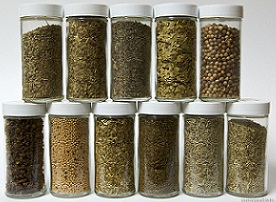 Want to add a bit of zing to your cooking? It can be confusing which herbs and spices to put in certain dishes, but with this guide you’ll be a pro home chef in no time.
Want to add a bit of zing to your cooking? It can be confusing which herbs and spices to put in certain dishes, but with this guide you’ll be a pro home chef in no time.
One of the big advantages of using herbs and spices is adding flavour to your food without the expense and calories of sauces – better for your waistline and your wallet! Get yourself a planter box for some fresh herbs and stock your pantry with dried herbs and spices. Here are some of the good basics:
Basil
A staple of Italian cooking that goes perfectly with oregano. Also great in salads when fresh – mix together some chopped basil leaves with a bit of olive oil and lemon juice for a quick and easy salad dressing. Use in lasagnes, spag bol, on pizzas etc. Tastes best when fresh, so skip the dried basil and go invest in a plant or herb paste instead.
Chilli
Chilli flakes or chilli powder are great for adding a bit of a kick to your cooking. Go easy on it though – this is only for those who like their food a bit spicier! Often a teaspoon is enough to add to a standard frying pan-sized portion of food. Mix it in and taste as you go to ensure you don’t make it too hot (and if you’re cooking for other people, remember not everyone likes hot food). Experiment with adding to stirfries, mexican dishes and quiches.
Coriander
Coriander, or Chinese Parsley, goes well in Thai cooking or with Mexican food such as tacos, quesadillas, burritos etc.). Chop it up and mix it in – try a small amount first as this herb can taste quite strong in some dishes.
Lemon Pepper
Sprinkle over fish and pan fry in a small amount of oil for an easy, great-tasting dish, or use as a seasoning on potato chips/wedges. Don’t sprinkle on too much though! Packaged lemon pepper can be quite strong, so use it sparingly.
Marjoram and oregano
These two herbs are close relatives so you can use them in the same way. Marjoram is a better option if you want a sweeter, milder flavour. They both go great in Italian cooking with basil – especially in tomato-based sauces.
Paprika
Put some paprika in egg dishes such as omelettes and quiches, and risottos to add warmth and spice to your meals. Find some smoked paprika for an even tastier addition to your food.
Rosemary
Gives chicken and roasts a fuller flavour. Try mixing rosemary with a bit of garlic, pepper and olive oil, then brush the mixture over some halved small potatoes and pop them into the oven for roasting. Also great with pork or lamb if you sprinkle a little on with pepper.
Sage
Often used with onion in stuffings, so if you’re going to be posh and make a stuffed chicken, try adding a bit of sage. Also good to add into home-made burger patties.
Thyme
Best with chicken, fish and vege dishes. Thyme is frequently used in Italian and French cooking. Try adding to rosemary, parsley and marjoram for a great herb combination in sauces, stews and casseroles.
Turmeric
This bright yellow powder is often added into rice dishes, giving a slight peppery taste and a bit of colour to your food. Turmeric is also a key ingredient in many curry powders. Try adding it to Indian or Middle Eastern food, or use in risottos or with seafood. Can also be used as a cheaper substitute for saffron.
Pre-mixed seasonings such as Garam Masala (Indian), Cajun and Moroccan mixes can also usually be found in the herbs and spices section of the supermarket. They are no-brainer flavours that will take the guesswork out of your cooking if you’re not sure where to start. Experiment to find out what you like!
Image / Flickr – Casey Fleser

